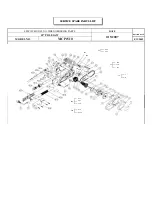
GROUNDING INSTRUCTIONS
ALL GROUNDED, CORD-CONNECTED TOOLS:
In the event of a malfunction or breakdown, grounding provides a path of least resistance for electric current to
reduce the risk of electric shock. This tool is equipped with an electric cord having an equipment-grounding
conductor and grounding plug. The plus must be plugged into a matching outlet that is properly installed and
grounded in accordance with all local codes and ordinances.
Do not modify the plug provided – if it will not fit the outlet, have the proper outlet installed by a
qualified electrician.
Improper connection of the equipment-grounding conductor can result in a risk of electric shock. The conductor
with insulation having an outer surface that is green with or without yellow stripes is the equipment-grounding
conductor. If repair or replacement of the electric cord or plug is necessary, do not connect the equipment-
grounding conductor to live terminal.
Check with a qualified electrician or service personnel if the grounding instructions are not completely
understood, or if in doubt as to whether the tool is properly grounded.
- 5 -
Ground Fault Interrupter (GFCI) protection should be provided on the circuit(s) or outlet(s) to be used for the tile
saw. Receptacles that have built-in GFCI protection are available; any may be used for this measure of safety.
TABLE 1
Volts
120 V
25 ft.
50 ft.
100 ft.
150 ft.
240 V
50 ft.
100 ft.
200 ft.
300 ft.
18
16
16
14
18
16
14
12
16
16
14
12
14
12
Not Recommended
Total length of cord in feet
More Than
Not More Than
0
6
6
10
10
12
12
16
AWG
Ampere Rating
• To avoid the possibility of the appliance plug or receptacle getting wet, position tile saw to one side of a wall
mounted receptacle to prevent water from dripping onto the receptacle or plug. The user should arrange a
“drip loop” in the cord connecting the saw to a receptacle. The “drip loop” is that part of the cord below the
level of the receptacle, or the connector if an extension cord is used, to prevent water traveling along the cord
and coming in contact with the receptacle.
• If the plug or receptacle does get wet, DO NOT unplug the cord. Disconnect the fuse or circuit breaker that
supplies power to the tool. Then unplug and examine for presence of water in the receptacle.
• Only UL Listed extension cords should be used with this product.
• Improper use of extension cords may cause inefficient operation of your tool, which can result in overheating.
Be sure your extension cord is rated to allow sufficient current flow to the motor. For the proper gauge for your
tool, see chart.
• Do not let your fingers touch the terminals of plug when installing or removing the plug to or from the outlet.
• If not properly grounded, this power tool can incur the potential hazard of electrical shock particularly when
used in damp locations or in proximity to plumbing. If an electrical shock occurs, there is the potential of
secondary hazard such as your hands contacting the saw blade.
Extension cords
1. Use only extension cords that are intended for outdoor use. These extension cords are identified by a marking
“Acceptable for use with outdoor appliances; store indoors while not in use.” Use only extension cords having
an electrical rating not less than the rating of the product. Do not use damaged extension cords. Examine
extension cord before using and replace if damaged. Do not abuse extension cords and do not yank on any
cord to disconnect. Keep cord away from heat and sharp edges. Always disconnect the extension cord from
the receptacle before disconnecting the product from the extension cord.
2. WARNING – to reduce the risk of electrocution, keep all connections dry and off the ground. Do not touch plug with
wet hands.
3. Ground Fault Circuit Interrupter (GFCI) protection should be provided on the circuit(s) or outlet(s) to be used for the
tile saw. Receptacles are available having built-in GFCI protection and may be used for this measure of safety.
60087_Manual.qxd:60087_Manual 4/23/09 4:04 PM Page 5





























